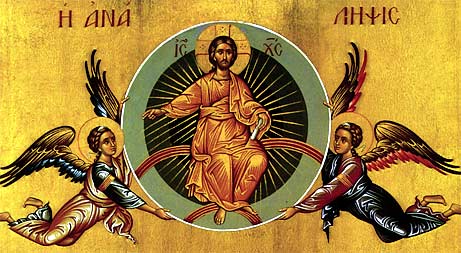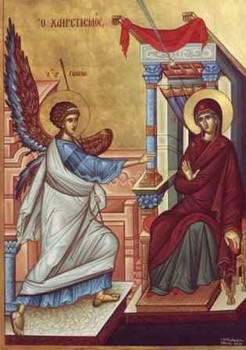Calendar
Christmas Eve
6. January 2015 - 18:53 In the evening of Christmas Eve a log cut from a tree, the Yule log (badnjak), is placed on the fire. This young tree, usually oak, symbolizes Christ and his entry into the world. Burning of the Yule log presents the warmth of Christ's love. Then, Christmas Eve is a reminder of the tree that the shepherds brought into the cave and which the righteous Joseph burn to warm the just born God-child in the cold cave.
In the evening of Christmas Eve a log cut from a tree, the Yule log (badnjak), is placed on the fire. This young tree, usually oak, symbolizes Christ and his entry into the world. Burning of the Yule log presents the warmth of Christ's love. Then, Christmas Eve is a reminder of the tree that the shepherds brought into the cave and which the righteous Joseph burn to warm the just born God-child in the cold cave.
Saint John Damascene
17. December 2014 - 14:42 John was first the chief minister to Caliph Abdul-Malik and later a monk in the Monastery of St. Sava the Sanctified. Because of his ardent defense of the veneration of icons during the reign of the iconoclastic Emperor Leo the Isaurian, John was maligned by the emperor to the Caliph, who cut off his right hand. John fell down in prayer before the icon of the Most-holy Theotokos, and his hand was rejoined and miraculously healed. Seeing this miracle the Caliph repented, but John no longer desired to remain with him as a nobleman. Instead, he withdrew to a monastery, where, from the beginning, he was a model to the monks in humility, obedience and all the prescribed rules of monastic asceticism. John composed the Funeral Hymns and compiled the Octoechos (The Book of Eight Tones), the Irmologion, the Menologion and the Paschal Canon, and he wrote many theological works of inspiration and profundity. A great monk, hymnographer, theologian and soldier for the truth of Christ, Damascene is numbered among the great Fathers of the Church. He entered peacefully into rest in about the year 776 at the age of 104.
John was first the chief minister to Caliph Abdul-Malik and later a monk in the Monastery of St. Sava the Sanctified. Because of his ardent defense of the veneration of icons during the reign of the iconoclastic Emperor Leo the Isaurian, John was maligned by the emperor to the Caliph, who cut off his right hand. John fell down in prayer before the icon of the Most-holy Theotokos, and his hand was rejoined and miraculously healed. Seeing this miracle the Caliph repented, but John no longer desired to remain with him as a nobleman. Instead, he withdrew to a monastery, where, from the beginning, he was a model to the monks in humility, obedience and all the prescribed rules of monastic asceticism. John composed the Funeral Hymns and compiled the Octoechos (The Book of Eight Tones), the Irmologion, the Menologion and the Paschal Canon, and he wrote many theological works of inspiration and profundity. A great monk, hymnographer, theologian and soldier for the truth of Christ, Damascene is numbered among the great Fathers of the Church. He entered peacefully into rest in about the year 776 at the age of 104.
Holy Great-Martyr Barbara
17. December 2014 - 14:14 This glorious follower of Christ was betrothed to Christ from early childhood. Her father Dioscorus was a pagan and was renowned for his position and wealth in the city of Heliopolis in Egypt. Dioscorus locked up his only daughter Barbara, brilliant in mind and of beautiful countenance, in a high tower.
This glorious follower of Christ was betrothed to Christ from early childhood. Her father Dioscorus was a pagan and was renowned for his position and wealth in the city of Heliopolis in Egypt. Dioscorus locked up his only daughter Barbara, brilliant in mind and of beautiful countenance, in a high tower.
He surrounded her with every comfort, gave her female servants, erected idols for worship, and built her a bathing room with two windows. Looking through the window at the earth below and the starry heavens above, Barbara's mind was opened by the grace of God. She recognized the One True God, the Creator, despite the fact that she did not have a human teacher to bring her to this knowledge. Once, while her father was away from the city, she came down from the tower and, according to God's providence, met some Christian women who revealed the true Faith of Christ to her. Barbara's heart became inflamed with love for Christ the Lord. She ordered that a third window be cut open in the bath so that the three windows would represent the Holy Trinity. On one wall she traced a Cross with her finger, and the Cross etched itself deep in the stone as if cut by a chisel. A pool of water sprang forth from her footprints on the floor of the bath, which later gave healing of diseases to many.
Entry of the Most Holy Mother of God into the Temple
4. December 2014 - 12:37 When the Most-holy Virgin Mary reached the age of three, her holy parents Joachim and Anna took her from Nazareth to Jerusalem to dedicate her to the service of God according to their earlier promise. It was a three-day journey from Nazareth to Jerusalem but, traveling to do a God-pleasing work, this journey was not difficult for them. Many kinsmen of Joachim and Anna gathered in Jerusalem to take part in this event, at which the invisible angels of God were also present. Leading the procession into the Temple were virgins with lighted tapers in their hands, then the Most-holy Virgin, led on one side by her father and on the other side by her mother. The virgin was clad in vesture of royal magnificence and adornments as was befitting the “King’s daughter, the Bride of God” (Psalm 45:13-15).
When the Most-holy Virgin Mary reached the age of three, her holy parents Joachim and Anna took her from Nazareth to Jerusalem to dedicate her to the service of God according to their earlier promise. It was a three-day journey from Nazareth to Jerusalem but, traveling to do a God-pleasing work, this journey was not difficult for them. Many kinsmen of Joachim and Anna gathered in Jerusalem to take part in this event, at which the invisible angels of God were also present. Leading the procession into the Temple were virgins with lighted tapers in their hands, then the Most-holy Virgin, led on one side by her father and on the other side by her mother. The virgin was clad in vesture of royal magnificence and adornments as was befitting the “King’s daughter, the Bride of God” (Psalm 45:13-15).
Following them were many kinsmen and friends, all with lighted tapers. Fifteen steps led up to the Temple. Joachim and Anna lifted the Virgin onto the first step, then she ran quickly to the top herself, where she was met by the High Priest Zacharias, who was to be the father of St. John the Forerunner. Taking her by the hand, he led her not only into the Temple, but into the “Holy of Holies,” the holiest of holy places, into which no one but the high priest ever entered, and only once each year, at that. St. Theophylact of Ohrid says that Zacharias “was outside himself and possessed by God” when he led the Virgin into the holiest place in the Temple, beyond the second curtain-otherwise, his action could not be explained. Mary’s parents then offered sacrifice to God according to the Law, received the priest’s blessing and returned home.
Our Ascended Lord: The Saving Swallow Who Opened the Way to the Eternal Spring
28. May 2014 - 12:32 Our Ascended Lord: The Saving Swallow Who Opened the Way to the Eternal Spring.
Our Ascended Lord: The Saving Swallow Who Opened the Way to the Eternal Spring.
by the Blessed Bishop Nikolai (Velimirovich) (†1956)
"When swallows run short of food and the cold weather is coming, they set off to warm climes, where there is plenty of sun and food. One swallow flies ahead, testing the air and showing the way, while the rest of the flock follows after.
When our souls run short of food in the material world, and when the cold of death draws near—ah, is there a swallow like that one, to take us to a warm place, where there is plenty of spiritual warmth and food? Is there such a place? Is there, oh, is there such a swallow?
The Annunciation of the Most Holy Mother of God
6. April 2014 - 21:32 The Feast of the Annunciation is one of the earliest Christian feasts, and was already being celebrated in the fourth century. There is a painting of the Annunciation in the catacomb of Priscilla in Rome dating from the second century. The Council of Toledo in 656 mentions the Feast, and the Council in Trullo in 692 says that the Annunciation was celebrated during Great Lent.
The Feast of the Annunciation is one of the earliest Christian feasts, and was already being celebrated in the fourth century. There is a painting of the Annunciation in the catacomb of Priscilla in Rome dating from the second century. The Council of Toledo in 656 mentions the Feast, and the Council in Trullo in 692 says that the Annunciation was celebrated during Great Lent.
The Greek and Slavonic names for the Feast may be translated as "good tidings." This, of course, refers to the Incarnation of the Son of God and the salvation He brings. The background of the Annunciation is found in the Gospel of St Luke (1:26-38). The troparion describes this as the "beginning of our salvation, and the revelation of the eternal mystery," for on this day the Son of God became the Son of Man.
There are two main components to the Annunciation: the message itself, and the response of the Virgin. The message fulfills God's promise to send a Redeemer (Genesis 3:15): "I will put enmity between you and the woman, between your seed and her seed; he shall crush your head, and you shall lie in wait for his heel." The Fathers of the Church understand "her seed" to refer to Christ. The prophets hinted at His coming, which they saw dimly, but the Archangel Gabriel now proclaims that the promise is about to be fulfilled.

